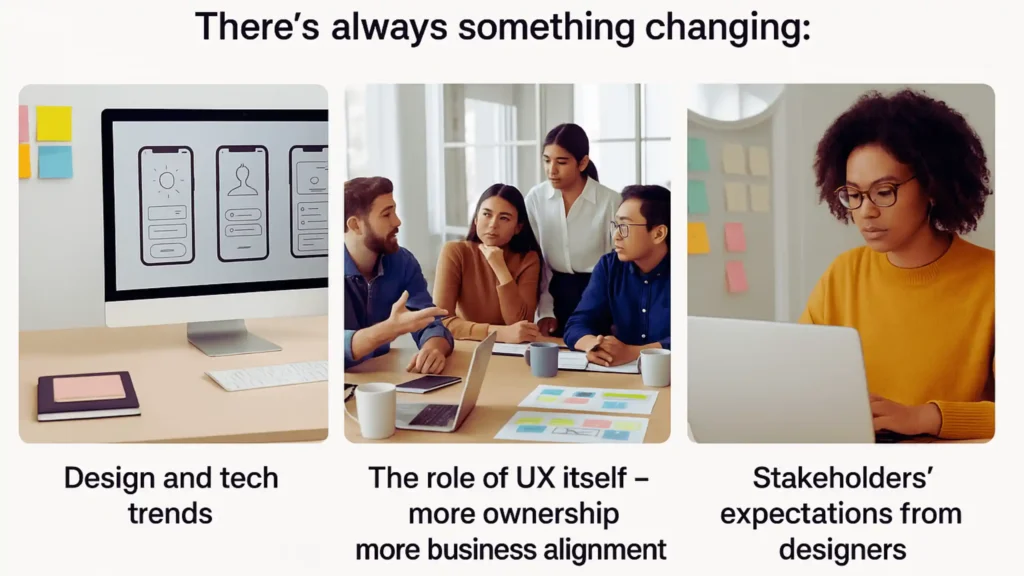Let’s talk about something a lot of mid-level designers quietly go through.
You’ve mastered the tools. Maybe it was Photoshop and XD back in the day, and now it’s Figma. You know your shortcuts, you design fast, maybe even teach others how to use these tools. But then… you hit a wall. A weird kind of saturation. It feels like you’re not growing anymore.
This happens because somewhere along the way, UX got reduced to screen design. To tools. As if UX equals Figma skills. (It doesn’t.) UX design is, and always was, way more than the tool you use to draw rectangles. In fact, the best experiences often begin outside any tool, on a whiteboard, in a conversation, or on a post-it.
At some point, many mid-level designers feel like, “I know everything there is to know.” And then, while digging deeper, they realize… they’ve barely scratched the surface.
So, who exactly is a mid-level designer?

Usually someone with 2–5 years of experience in UX. You’ve likely:
- Led design in at least a few projects
- Owned flows or user journeys partially and end-to-end
- Worked in specialised roles for usability, interaction design, research, or UI, maybe all of them
- Been an individual contributor and drove decisions
- Held titles like “UX Designer 2 or 3,” “Senior UX Designer,” or even “Lead Designer” or “Design Manager” (though in reality, it was only a job title and the scope is still mid-level)
You’ve probably had success. But now the question is, what next?
Why mid-level is the most critical stage to upgrade

UX isn’t a fixed playbook. It keeps evolving. Usage habits shift. Cultures influence interactions. Tech moves fast. What was considered poor UX five years ago is suddenly normal today. Remember when horizontal carousels were considered a usability sin? Now they’re everywhere.
There’s always something changing:
- Design and tech trends
- Work cultures and team structures
- The role of UX itself – more ownership, more business alignment
- Stakeholders’ expectations from designers
- And most importantly, what users expect from the products we design
UX has become an umbrella. It swallowed up research, strategy, systems thinking, interaction, accessibility, and more. If you’re not adapting, you’re falling behind.
Signs you need to level up
How do you know it’s time to move to an advanced UX design course or mentorship?
- You’ve only been solving someone else’s problems. You’re given a brief, you execute. But you’re rarely part of defining the problem itself.
- You’ve been working in a bubble. No stakeholder engagement. No room to influence direction. You feel shut down in meetings.
- You’ve never validated your designs. Or if you did, it was surface-level feedback post-launch.
- You’re stuck in one domain. You know fintech really well, or ed-tech maybe. But throw you into a healthcare or enterprise product and you’re lost.
- You’ve been designing screens, not systems. Flows that make sense on one screen, but not across the user’s journey.
- You feel unheard. You’re trying to bring a UX perspective to engineering or business folks, but they either push back or ignore you. And you don’t know how to change that.
- You’re tired of saying “they don’t get UX.” Maybe it’s time you get better at influencing them.
- You’re not collaborating confidently with other teams. Tech, product, marketing, sales—something always feels off or misaligned.
- You feel stuck in your role. The promotions stopped. The pay hikes are minimal. You’ve been “senior” for 2 years now.
And let’s be honest—even if none of these apply today, they might tomorrow. Because UX is moving. Fast.
What does “scaling up” actually mean?
It’s not about learning more tools. It’s about changing the way you think as a designer.
You learn how to:
- Solve real business problems with design
- Think beyond aesthetics – into systems, flows, outcomes
- Integrate research properly (not just fake empathy maps)
- Collaborate with other practices without friction
- Tell stories with data, not opinions
- Design across devices, touchpoints, and channels—not just features
- Build design strategies that teams can actually implement
- And position UX on top of the funnel
The goal is to become someone who’s not just executing design but leading it.
You don’t need a crisis to upskill
Sometimes we wait too long. We wait until we feel stuck or burned out. But the best time to learn is before that happens. Upskilling shouldn’t be reactive. It should be part of your normal growth.
Because when you don’t, the gaps start showing up, subtle at first. You start getting frustrated with the team. You stop seeing results. Your ideas don’t land. You lose confidence. You settle.
Keep learning. Keep scaling.
If you’re a mid-level designer and any of this feels familiar, don’t ignore it. This is your cue.
Start looking at UX from a new lens. Seek mentorship. Take up courses that don’t just teach you tools, but strategy, systems, and cross-functional skills.That’s how mid and senior level UX designers stay ahead; they evolve with the industry, not behind it.
At Xperience Wave, that’s exactly what we do through the Certified Core UX Design (CCD) course. It’s built to help mid-level designers scale into high-impact roles, leaders, not just doers.
So be on top of your growth.
Because learning is not optional
